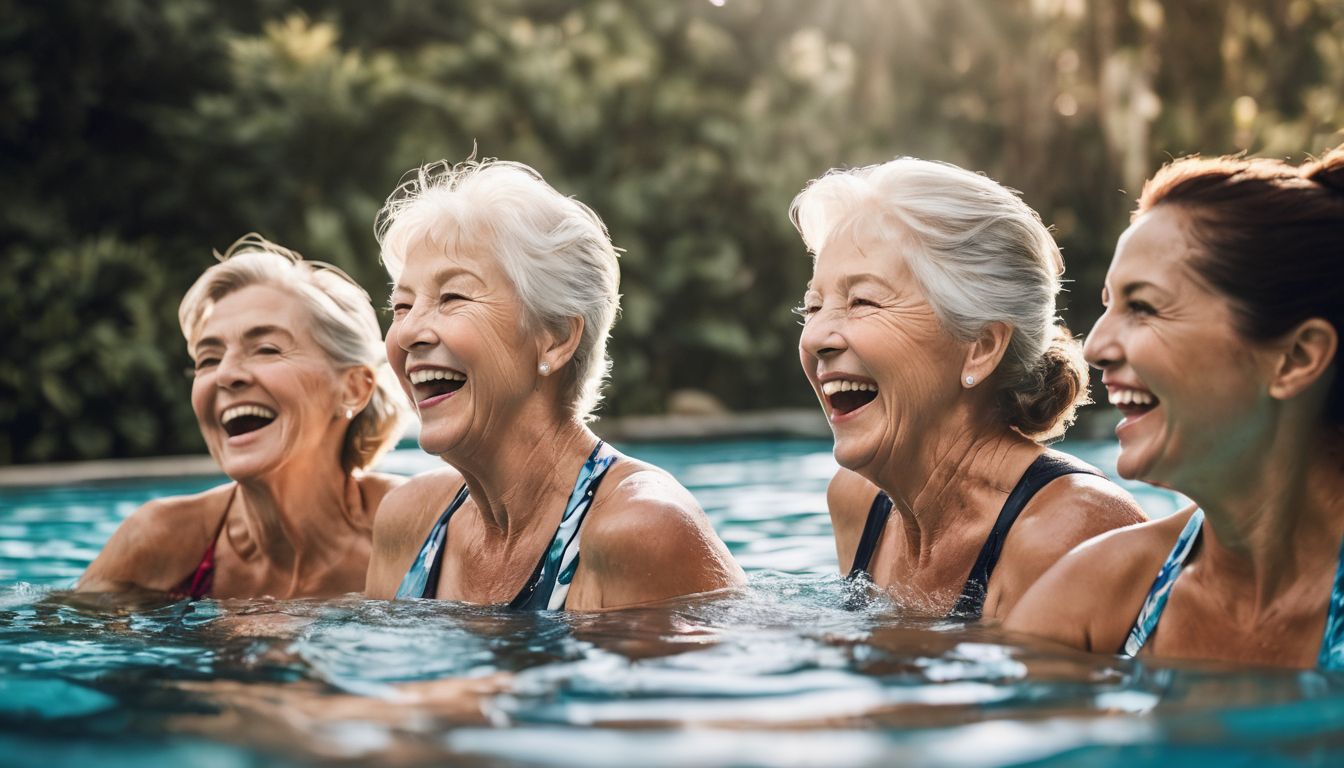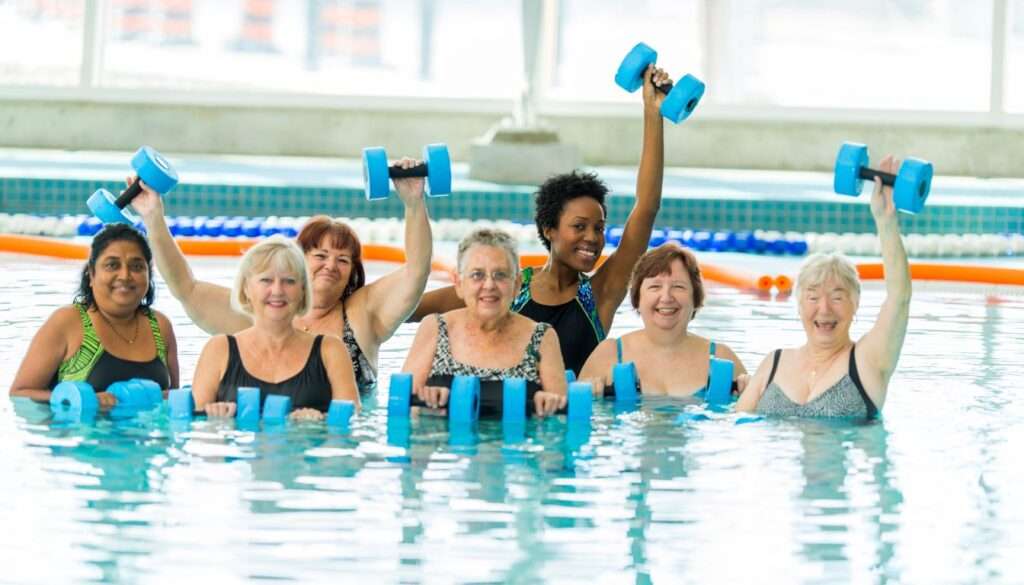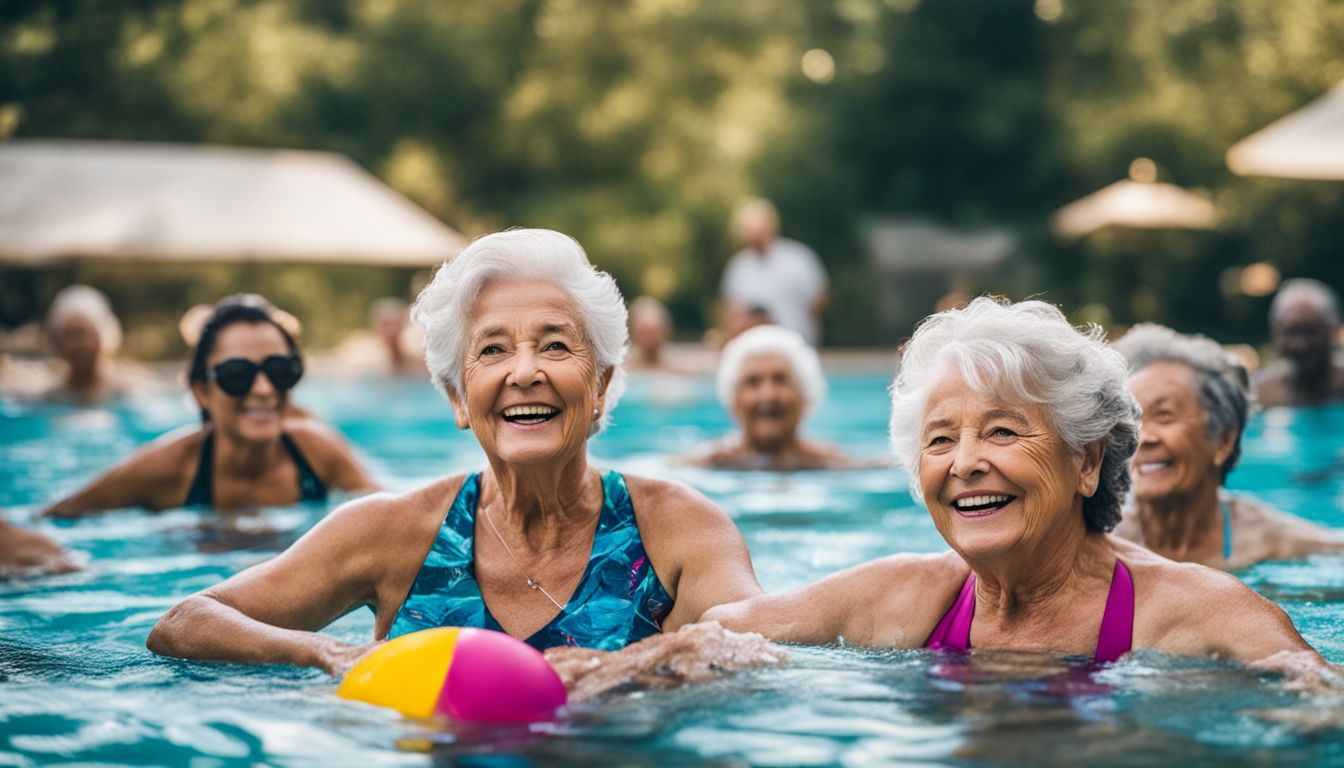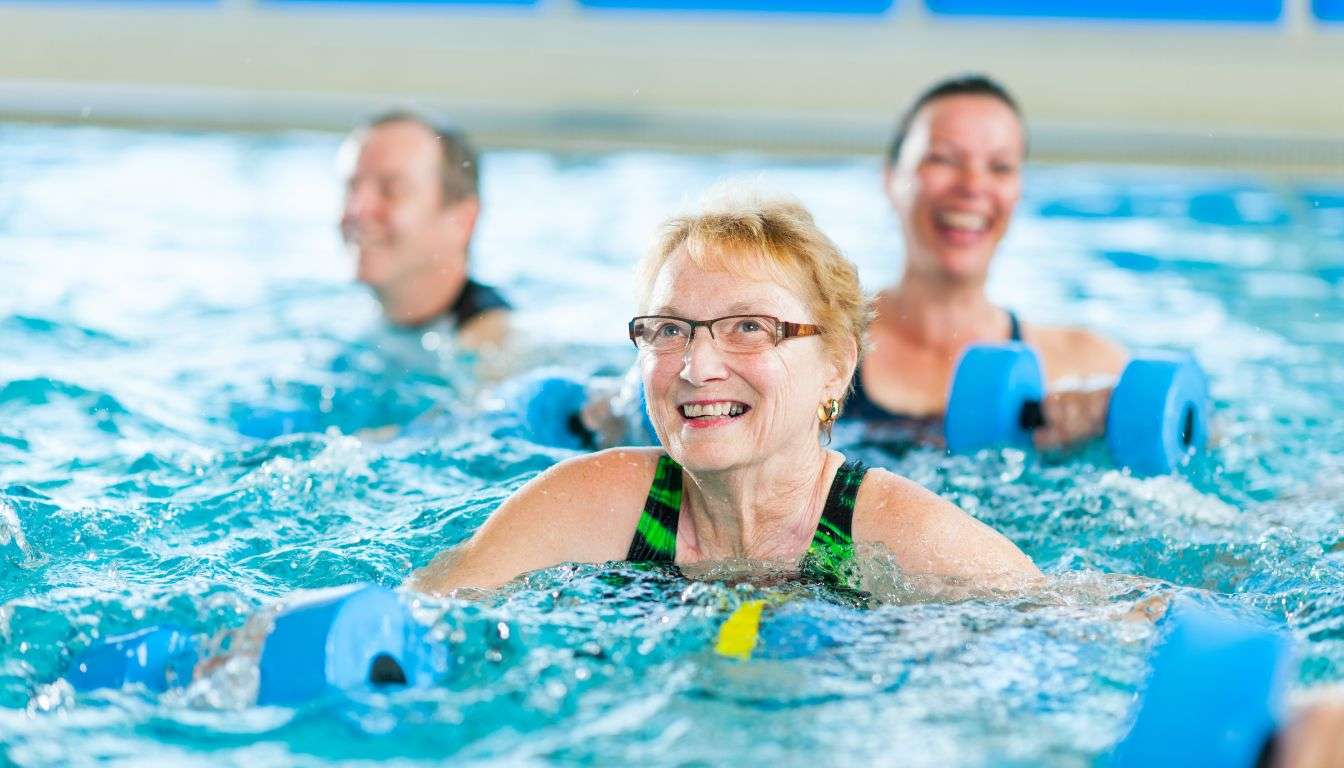As we age, maintaining balance can become a daily challenge, often leading to a fear of falling and injury. Did you know that water exercises are particularly beneficial for seniors seeking to improve their stability? This blog is your gateway to understanding how aquatic workouts not only safeguard against falls but also provide numerous health advantages without straining the body.
Dive in with us!
Key Takeaways
- Water exercises are a low-impact way for seniors to improve balance, reduce fall risk, and build strength without straining their bodies.
- The buoyancy of water makes these exercises joint-friendly, especially helpful for those with arthritis or after joint replacement surgery.
- Water workouts enhance muscle endurance and cardiovascular health while also being gentle on the joints compared to land-based exercises.
- Performing water exercises can improve mood, mental outlook, and may lead to better sleep patterns in seniors.
- Group water exercise classes offer social interaction and can be a safe, enjoyable way for older adults to stay active and connected.
The Benefits of Water Exercises for Seniors

Diving into the pool isn’t just for fun; it’s a fountain of youth for seniors seeking to boost their health and mobility. Water exercises offer a low-impact yet highly effective way to enhance physical strength and stability, paving the wave toward a more balanced and vibrant lifestyle.
Improved Balance, Decreased Risk of Falls
Water exercises are great for seniors who want to stay steady on their feet. Moving through water builds balance skills without the risk of falling down hard like you might on land.
Think of the pool as a safe place where you can work your muscles and sharpen your balance at the same time.
For example, standing in waist-deep water and shifting from one foot to the other strengthens legs and core — key players in keeping upright. And because falls can be scary, especially as we get older, practicing these moves in water is perfect.
It’s like having a built-in safety net!
Improved Strength and Endurance
Exercising in water is more than just splashing around. It’s a powerful way to build muscle strength and boost endurance without straining your body. In the pool, every move works against the gentle pressure of the water, which makes your muscles work harder.
Think of it like having built-in resistance training at every turn. You might march, jump, or perform arm curls, and with each repetition, you’re gaining power and lasting energy.
As we age, keeping our bodies strong is essential for health and fitness. Water aerobics offers that strength exercise seniors need without the harsh impact on joints like knees and hips.
Imagine lifting water weights or using kickboards; these activities are not only fun but also increase muscular endurance over time. They help keep hearts healthy too, by blending cardio exercise into each session—making sure that life’s later years are active ones!
Unloading the Joints
Water exercises work wonders for easing your joints. Imagine moving around without feeling weighed down by gravity. In the pool, you’re lighter, and that means less strain on your knees, hips, and back.
Movements become smoother, letting you bend and stretch in ways that might hurt on land.
This gentle approach helps if you have arthritis or have had joint replacements. Aquatic therapy allows you to exercise sore muscles with less pain. It’s like giving your joints a vacation while still building strength and staying active.
With each step or arm curl in water, you’re caring for your body without the harsh impact of regular workouts.
Reduced Risk of Falls
Easing the load on joints paves the way for another significant benefit: a safer experience that cuts down on falling. With water’s built-in buoyancy, seniors find themselves more stable and secure.
The risk of a painful tumble is less in a pool where water supports you from all sides.
Exercising in water makes it easier to build up balance without fear of falling over. Gentle resistance helps older adults strengthen muscles crucial for staying upright. This means better balance on land, too! Aquatic therapy provides gentle forces that challenge stability just enough to make improvements while keeping safety at the forefront.
Enhanced Mental Outlook
Water workouts are more than just physical activities; they boost your mood and clear your mind. Splashing around can fight off blues and anxiety and help keep depression at bay. Mixing up strokes and pace in the pool keeps your mind engaged while your body exercises.
It’s a total win-win for feeling great.
Imagine diving into the water and leaving stress on the shore. These aquatic routines work magic for both brainpower and spirits. Regular swims or aerobic workouts refresh your outlook on life, giving you the energy to enjoy every moment with friends or family.
Dive in—the water’s fine, and so will your mental state!
Beneficial Properties of Water for Seniors

Exercise in water makes you feel lighter. It can hold up some of your weight. This helps seniors move with less pain and more ease, especially if they have joint issues like arthritis.
The water’s buoyancy reduces the impact on sore hips, knees, and backs.
Warm pools relax muscles, which is great for those stiff from conditions like osteoarthritis or Parkinson’s disease. Moving in water also builds muscle strength because it’s thicker than air.
Legs and arms must push harder through water than through air. This gentle resistance helps grow stronger muscles without needing weights.
Swimming and other pool exercises get hearts pumping, too. They improve cardiovascular health by making the heart work a bit harder than usual but safer than some gym workouts. Good blood flow is key to keeping body parts healthy and working well as folks age.
Seniors who exercise in the pool might find that they sleep better at night. Better sleep helps bodies heal, and minds stay clear.
Water also supports social interaction; joining a class can help older adults make new friends, share laughs, and shake off loneliness—a boost for mental health!
Top Water Exercises for Seniors

Diving into water workouts, seniors can explore a refreshing variety of exercises tailored to enhance their physical well-being—each move designed to gently boost strength while guarding against injury.
From the buoyant resistance that sculpts muscles to the calming rhythm of aquatic movements, these activities promise both safety and fun for the older adult looking to maintain an active lifestyle.
Aqua Walking or Jogging
Aqua walking and jogging are great for seniors who want to improve their posture and balance. These water exercises make you feel light on your feet, thanks to the water’s buoyancy.
They provide a safe environment where you won’t fall easily, making them perfect for maintaining an active lifestyle.
Move at your own pace while enjoying the resistance of the water against your movements. Leg muscles get stronger as they push through the water, which helps with daily activities outside the pool.
Plus, it’s fun to mix up your routine with something different from typical land-based workouts!
Arm Curls
Arm curls in the pool are great for building stronger arms. You can do them with or without water weights. To start, stand nice and tall in the water. Keep your feet flat on the bottom of the pool.
Hold your arms down by your sides with palms facing forward. If you have weights, hold onto them gently.
Now, bend your elbows to curl your hands up towards your shoulders, just like doing arm curls on land but with the added resistance of water. This helps work out those biceps and triceps more effectively! Slowly lower your arms back down and repeat this movement several times.
Try for two sets of 10-15 repetitions each to help increase upper body strength over time.
Flutter Kicking
Flutter kicking is a gentle yet effective way to strengthen your legs in the water. You’ll feel like a swimmer without the strain of laps. Picture yourself lying on your back or holding onto the pool edge, kicking your legs with a light and rhythmic motion.
Your hip flexors, hamstrings, glutes, and calves all get toned from this simple movement.
This kicking action also helps with balance and coordination. Warm water makes it even better by relaxing muscles and boosting blood flow. It can aid healing for those who have joint issues or are in rehabilitation.
Try flutter kicks next time you’re in the pool for low-impact strength training that’s easy on your body but tough on calories!
Standing Water Push-ups
Standing water push-ups are like a magic trick for your muscles. They work your arms, chest, and shoulders while being gentle on joints. Imagine pushing against the pool wall; that’s how you do them.
Face the side of the pool and place your hands shoulder-width apart on the edge. Lean in as if doing a regular push-up, but let the water take some of your weight. This makes it easier to lift yourself up.
With buoyancy on your side, standing water push-ups become less painful, even if you’ve had knee replacements or arthritis. Push away from the wall and glide back with control – that’s how you build strength without strain.
After finishing a set of push-ups, get ready to give those legs some attention with leg lifts next!
Leg Lifts
Leg lifts are great for improving balance and building strength in seniors. In the water, these exercises become even more beneficial. The water’s buoyancy takes pressure off the joints.
This is especially helpful for those with arthritis or who have had joint replacement surgery. To do leg lifts, stand in water up to your waist or chest. Hold onto the side of the pool for support if needed.
Raise one leg to the side, keeping it straight, then bring it back down slowly. This move works your hips and thighs while helping you stay upright and balanced. It’s like having a physical therapist right there in the pool with you! Switch legs and repeat.
Aim to lift each leg about 10-15 times on each side at a moderate pace – this helps build that important muscle around your pelvis and core area without straining yourself.
Water Marching
Water marching helps seniors stay steady on their feet. It’s a great way to build leg strength and boost heart health. You’ll march through the water just like on land, but with less strain on your joints.
If you have arthritis or joint pain, the buoyancy of the water takes the pressure off while you move.
This exercise can improve your quality of life, especially if you have conditions like MS or Parkinson’s disease. Warm water heightens body awareness and relaxes muscles for better balance and movement.
Next up: another excellent activity to keep fit in the pool – swimming!
Swimming
Swimming has earned its place as a favorite exercise among older adults. It’s like a power-up for the body, targeting many areas all at once. Your muscles get stronger, your heart gets pumping, and you’ll find yourself moving with greater ease both in and out of the pool.
The best part? You’re giving your joints a break because swimming is easy on them, too.
Imagine every stroke making you more flexible and helping to keep your balance sharp. Water’s gentle support lets seniors glide through their routine without fear of falling. Plus, it’s not just about physical health; swimming can be a peaceful time for reflection or an invigorating way to mix up your day-to-day activities.
Dive in—the water’s great for maintaining an active lifestyle!
Water Exercises vs. Traditional Exercises

Water exercises offer a refreshing twist to staying active for seniors, providing a unique set of benefits that traditional exercises might not deliver. The buoyancy and resistance of water can transform a workout routine, making it gentler on the body while still effective.
– **Joint-Friendly Workout**: Unlike traditional land exercises, water workouts don’t put as much strain on the joints. The water supports your weight, making movements smoother and reducing the risk of injury. This is especially beneficial for seniors with arthritis or other joint conditions.
– **Increased Resistance Leads to Strength**: Moving through water provides a natural resistance, which can strengthen muscles without the need for weights. This resistance is uniform and can be adjusted by changing the speed or surface area; slower movements with wide holds in the water can significantly work your muscles.
– **Balance and Stability Boost**: The water’s pressure helps stabilize seniors during exercise, which improves balance and coordination. This is crucial in everyday life, as good balance can prevent falls and injuries.
– **Cardiovascular and Muscle Endurance**: Water exercises can elevate the heart rate and improve circulation, just like traditional exercises. However, the water’s coolness helps prevent overheating, allowing for a longer and more comfortable workout.
– **Calorie Burn with Less Impact**: The effort required to move against water’s resistance means seniors can burn calories effectively, similar to traditional exercises, but with less impact on the body. This is key for maintaining a healthy weight and improving overall fitness.
– **Flexibility and Range of Motion**: Water’s buoyant effect allows for a greater range of motion as it supports limbs, enabling seniors to perform stretches and movements that might be difficult on land. This can lead to better flexibility and mobility over time.
– **Social Interaction with Safety**: Group water exercise classes provide a social atmosphere that can boost mental health, but with the added safety of being in a controlled environment. This camaraderie can make sticking to a fitness regimen easier and more enjoyable.
– **Therapeutic Effect of Water**: Warm water can soothe sore muscles and reduce pain, offering a therapeutic aspect to exercise. This can be particularly comforting for seniors dealing with chronic pain or recovering from surgery.
Each of these points illustrates the distinct advantages water exercises have over traditional workouts for seniors. The combination of safety features, potential for strength building, and the therapeutic nature of water makes aquatic workouts an excellent choice for older adults looking to maintain or improve their physical health.
Conclusion
Staying active in the golden years is key, and water exercises offer a fun twist. They’re easy on the joints yet tough on muscle weakness—perfect for keeping balance sharp. Plus, they boost heart health and lighten moods, all while splashing around! Seniors can safely strengthen their bodies and enjoy every refreshing moment.
Dive into water workouts; they’re more than just a splash—they’re a smart move for staying steady and strong!
FAQs
1. Why are water exercises good for seniors?
Water exercises are great for seniors because they improve balance and strength without putting too much strain on the body. They help build muscles like the abdominals, adductors, and latissimus dorsi in a safe way. This can prevent falls and keep you healthy.
2. What kind of health problems can water exercising help with?
Doing exercises in the water can lower your chance of getting chronic conditions such as heart disease, type ii diabetes, osteoporosis, and obesity. It’s also known to ease joint inflammation and pain relief which is common in aging.
3. Can doing squats in water really make my legs stronger?
Absolutely! Water squats strengthen your lower body by working out important muscles like your gastrocnemius – that’s your calf muscle – quads, hamstrings, and glutes!
4. How might swimming affect my sleep patterns or weight loss goals?
Swimming gently moves all parts of your body which helps you sleep better at night; plus it boosts metabolism to help lose weight safely when paired with a balanced diet.
5. Do I need special training from physical therapists to do these exercises?
While some people may prefer guidance from professionals such as caregivers or physical therapists—especially if recovering from an injury—you don’t always need them for basic moves like chest flys or hip abductions.
6. Are there easy water exercises that work on core strength for older adults?
Yes! Try floating while doing movements that target your transverse abdominis—that’s the deep core muscle around your spine—and obliques near your ribcage; this will definitely ramp up that core strength!





